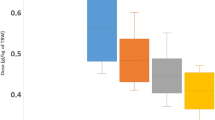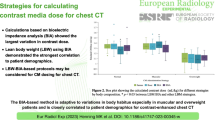Abstract
The dosage of contrast agents for computed tomography contrast studies is calculated based on the parameter of actual body weight (ABW) to ensure reproducibility. The use of lean body weight (LBW) and adjustment for physique (lean or obese) improves accuracy. However, this method is complex, because LBW is not a general body parameter and requires a special device to measure. To solve this problem, contrast body weight (CBW), has been proposed as a new and simple parameter that considers physique. CBW is calculated by determining the blood volume ratio based on body height, ABW, and sex and can potentially correct for body size. It can be calculated by entering a formula in a Microsoft Excel sheet. Since CBW can be easily obtained using this general tool, we decided to compare the two body parameters of ABW and CBW. We compared ABW and CBW and demonstrated a higher correlation between CBW-based dosing and the amount of iodine used per body weight than with ABW-based dosing. CBW-based dosing allows correction for body size. This indicates that contrast enhancement over a spectrum of lean or obese examinees can be linearly evaluated. To date, this method has shown good results.









Similar content being viewed by others
References
Bae KT, Heiken JP, Brink JA. Aortic and hepatic peak enhancement at CT: effect of contrast medium injection rate—pharmacokinetic analysis and experimental porcine model. Radiology. 1998;206:455–64.
Bae KT, Heiken JP, Brink JA. Aortic and hepatic contrast medium enhancement at. Radiology. 1998;207:647–55.
Fleischmann D, Hittmair K. Mathematical analysis of arterial enhancement and optimization of bolus geometry for CT angiography using the discrete Fourier transform. J Comput Assist Tomogr. 1999;23:474–84.
Fleischmann D, Rubin GD, Bankier AA, et al. Improved uniformity of aortic enhancement with customized contrast medium injection protocols at CT angiography. Radiology. 2000;214:363–71.
Awai K, Hatcho A, Nakayama Y, et al. Simulation of aortic peak enhancement on MDCT using a contrast material flow phantom: Feasibility study. Am J Roentgenol. 2006;186:379–85.
Hatcho A. Contrast enhancement theory for CT: Effects of concentration, volume, and injection flow rate of iodine contrast media on TDC. Eizo Joho Med. 2007;39(6):604–9 ((in Japanese)).
Terasawa K, Hatcho A. Contrast enhancement technique in brain 3D-CTA studies: optimizing the amount of contrast medium according to scan time based on TDC. Nihon Hoshasen Gijutsu Gakkai Zasshi. 2008;64(6):681–9 ((in Japanese)).
Terasawa K, Maruyama A, Tsukimata T. A new method with variable-injection parameters in contrast enhanced CT: a phantom study for evaluating an aortic peak enhancement. Radiol Phys Technol. 2015;8(2):248–57.
Heiken JP, Brink JA, McClennan BL, et al. Effect of volume and concentration of contrast material and patient weight on hepatic enhancement. Radiology. 1995;195:353–7.
Yamashita Y, Komohara Y, Takahashi M, et al. Abdominalhelical CT; evaluation of optimal doses of intravenous contrast material-a prospective randomized study. Radiology. 2000;216:718–23.
Awai K, Hiraishi K, Hori S. Effect of contrast material injection duration and rate on aortic peak time and peak enhancement at dynamic CT involving injection protocol with dose tailored to patient weight. Radiology. 2004;230:142–50.
Guyton AC, Hall JE. Textbook of medical physiology. 12th ed. Philadelphia: WB Saunders; 2011. p. 157–66.
Sjostrand T. The total quantity of hemoglobin in man and its relation to age, sex, bodyweight and height. Acta Physiol Scand. 1949;18(4):324–36.
Cohn J. Shock NW: blood volume studies on middle aged and elderly males. Am J Med Sci. 1949;217(4):388–91.
Van Dyke DC, Contopoulos AN, Williams BS, et al. Hormonal factors influencing erythropoiesis. Acta Haematol. 1954;11(4):203–22.
Berlin NI, Hyde GM, Parsons RJ, et al. The blood volume in cancer. Cancer. 1955;8(4):796–802.
Underwood PS, Howland WS. Serial blood volume determinations associated with major cancer surgery. Anesth Analg. 1966;45(6):797–803.
Bae KT, Seeck BA, Hildebolt CF, et al. Contrast enhancement in cardiovascular MDCT: effect of body weight, height, body surface area, body mass index, and obesity. AJR Am J Roentgenol. 2008;190(3):777–84.
Kondo H, Kanematsu M, Goshima S, et al. Abdominal multidetector CT in patients with varying body fat percentages: estimation of optimal contrast material dose. Radiology. 2008;249:872–7.
Awai K, Kanematsu M, Kim T, et al. The optimal body size index with which to determine iodine dose for hepatic dynamic CT: a prospective multicenter study. Radiology. 2016;278(3):773–81.
Terasawa K, Watanabe N, Tanaka K, et al. Optimization of CT contrast studies using a simple new dosing regimen that incorporates body mass index. Rad Fan. 2020;18(2):93–102 ((in Japanese)).
Kunimoto A, Kikunaga S, Okazaki K, et al. BMI and body dissatisfaction values in Japanese male and female university students —difference in body images according to shilhouette chart-. JJHEP. 2017;25(2):74–84 ((in Japanese)).
Guyton AC. Circulatory physiology: cardiac output and regulation. Philadelphia: WB Saunders; 1963. p. 173.
Kidoh M, Nakaura T, Oda S, et al. Contrast enhancement during hepatic computed tomography: effect of total body weight, height, body mass index, blood volume, lean body weight, and body surface area. J Comput Assist Tomogr. 2013;37(2):159–64.
Kanda Y. Investigation of the freely available easy-to-use software “EZR” for medical statistics. Bone Marrow Transplant. 2013;48(3):452–8.
Terasawa K. Contrast enhanced computed tomography (CT) techniques. In: Takagi T, editor. Standardization in X-Ray CT Imaging-GALACTIC, 2 edn. Tokyo-japan: Ohmusha; 2019. p. 138–52.
Hume R. Prediction of lean body mass from height and weight. J Clin Pathol. 1966;19:389–91.
Hallynck TH, Soep HH, Thomis JA, et al. Should clearance be normalised to body surface or to lean body mass? Br J Clin Pharmacol. 1981;11:523–6.
Allen TH, Peng MT, Chen KP, et al. Prediction of total adiposity from skinfolds and the curvilinear relationship between external and internal adiposity. Metabolism. 1956;5(3):346–52.
Nadler SB, Hidalgo JH, Bloch T. Prediction of blood volume in normal human adults. Surgery. 1962;51(2):224–32.
Ogawa R, Fujita T, Fukuda Y. Study on normal circulating blood volumes in Japanese people. Respir Circ. 1970;18(9):79–84.
Ichimura S. The estimation of distribution function of rohrer-index at each level of height. Jpn J Phys Educ. 1969;14(1):44–51.
Itoh K, Murata M, Sugihara S. Problems using body mass index or Rohrer index as indicators for defining childhood obesity. Tokyo Joshi Ikadaigaku Zasshi. 2007;77(5):18–21 ((in Japanese)).
Tang K, Wang L, Li R, et al. Effect of low tube voltage on image quality, radiation dose, and low-contrast detectability at abdominal multidetector CT: phantom study. J Biomed Biotechnol. 2012;2012:130–69.
Author information
Authors and Affiliations
Corresponding author
Ethics declarations
Conflicts of interest
All authors have approved the content and submission of the manuscript. The authors declare no particular conflicts of interest relevant to this manuscript. We have received no research grant funding for this study.
Ethics approval
All procedures performed in studies involving human participants were adhered to the ethical standards of the institutional and/or national research committee (include name of committee + reference number) and with the 1964 Helsinki declaration and its later amendments or comparable ethical standards.
Informed consent
Informed consent was obtained from all individual participants included in the study.
Additional information
Publisher's Note
Springer Nature remains neutral with regard to jurisdictional claims in published maps and institutional affiliations.
About this article
Cite this article
Terasawa, K., Tanaka, K., Watanabe, N. et al. Optimization of computed tomography contrast studies with a new, simple dosing regimen incorporating body size: examination of contrast effects in the thoracoabdominal aorta. Radiol Phys Technol 14, 149–160 (2021). https://doi.org/10.1007/s12194-021-00609-3
Received:
Revised:
Accepted:
Published:
Issue Date:
DOI: https://doi.org/10.1007/s12194-021-00609-3




